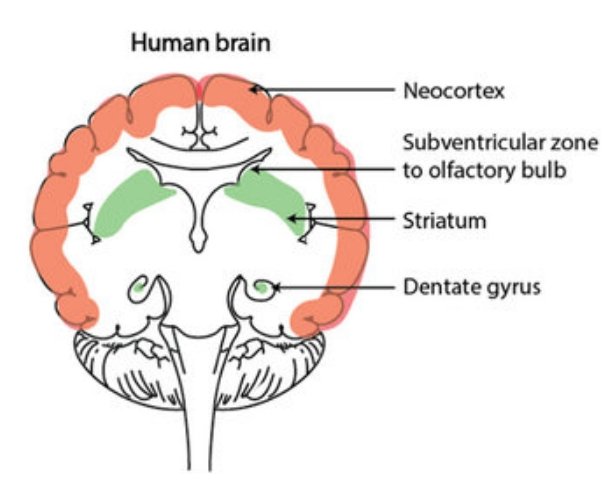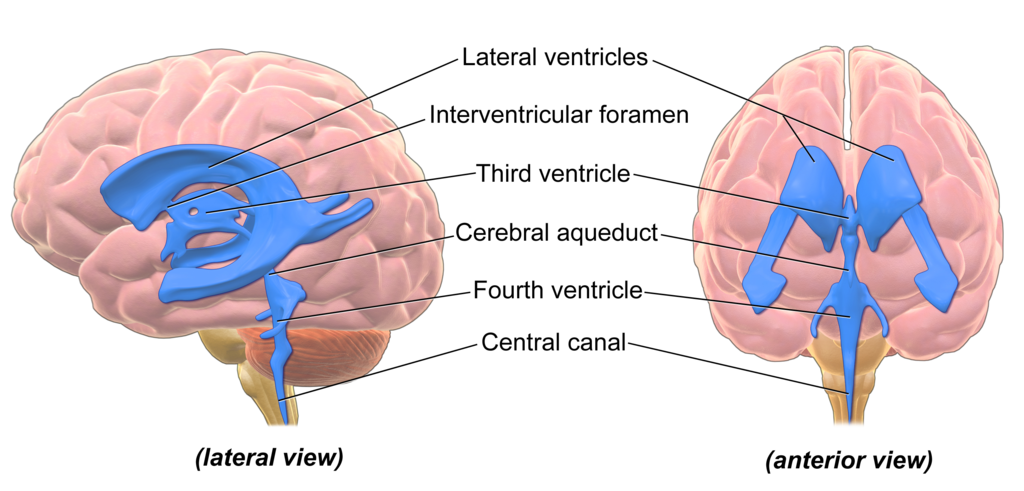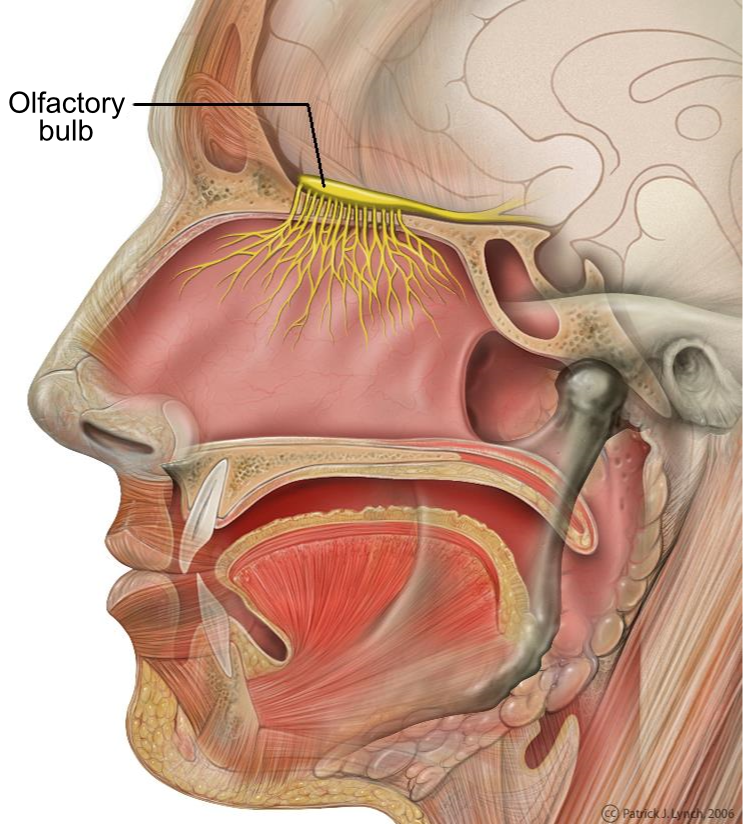Chap4 Brain Neural Stem Cells to Cure Depression (Brain Injury)
Neural Stem Cell
Our body is equipped with a mechanism to heal the brain injury caused by depression. It is a natural healing power.The specific bearer of the brain’s natural healing power is a versatile cell called a neural stem cell. When these neural stem cells grow healthily, they fill in the injury of the brain. *1),2),3),7)
In this story, I will explain the neural stem cells in the brain that heal the brain injury of depression.
Summary of past related stories
This is a summary of the first four stories in the series on “Complete Curing Depression with Acupuncture” so that you can better understand the brain neural stem cells in this story.1) Strong stress creates injury in the amygdala of the brain.
Depression is caused by injury in the amygdala of the brain.
2) When there is stress, the brain secretes an anti-stress hormone to protect the body from stress. It is called cortisol. Cortisol is roughly equivalent to the famous steroid.
3) If cortisol stays for a short period of time, it protects the body from stress. However, when stress becomes chronic, cortisol continues to be produced without stopping, which in turn damages the brain cells. This creates brain injury that will lead to depression. *3)
4) The cell in the amygdala of brain injury and muscle stiffness are created by chronic stress. Brain cell damage is depression itself, but muscle stiffness will aggravate brain injury and prevent recovery.
For more details, please see the related pages from the table of contents below.
Table of Contents for the Previous Stories
This is the table of contents for the previous articles related to this article.Chapter 1 Preface and Overview.
Chapter 2 Depression is an Injury in the Brain from Stress.
Chapter 3 Amygdala Injury: Stress Causes Brain Injury and Muscle Stiffness.
Chapter 3b Muscle Stiffness: Stress Causes Brain Injury and Muscle Stiffness.
Neural Stem Cells Heal Brain Injuries
Traditionally, it was thought that once brain cells are damaged, they cannot be healed.However, recent medical information indicates that it is an established fact that brain cell injury can be healed in the same way that a wound on the palm of the hand can be healed naturally.
Neural stem cells play a central role in the healing of brain injury. Incidentally, skin stem cells heal injury on the palm of the hand.
Neural stem cells are like baby brain cells. When these babies grow up well and become adults, they fill in the injuries in the brain. And depression will be cured.
Stress inhibits the recovery of brain injuries.
Stress inhibits the recovery of brain injuries.Fragile Baby
Since neural stem cells are like babies, they are vulnerable and need to be well protected.In the case of 24 hours of uninterrupted stress, cortisol causes brain nerves to atrophy and creates cell death. Similarly, cortisol produced by stress also kills neural stem cells.
Even if neural stem cells, which are babies, are born one after another, they will soon die and the injury will not be able to be filled.
This means that increasing the number of neural stem cells in the brain will not fill the injuries in the brain.
In general, the treatment of depression that is widely used in hospitals does not solve the problem of excessive cortisol secretion.
This causes chronic depression without being cured.
That is the problem now that the treatment of depression has.
Stiffness in the muscles
In the Charter 3 story, I explained that there are two types of stress. The first is primary stress and the second is secondary stress. Primary stress includes relationships, long working hours, and loneliness. Secondary stress is stiffness in the muscles of the body.The stress that lasts for 24 hours and never goes away is muscle stiffness.
In other words, if you remove muscle stiffness, the stress that lasts for a long time will disappear, the neural stem cells will grow healthily, and the stem cells that were babies will become adults.
The only way to cure depression is to remove muscle stiffness. It’s simple, but it’s the best way.
Acupuncture is the most effective way to relieve muscle stiffness.
The acupuncture treatment for depression will be explained in detail in the next story.
The Relationship between Neural Stem Cell Count and Aging
Neural stem cells fill in injuries in the brain, not just those created by depression.It is intuitive to understand that brain injury can be healed in young people. In contrast, the question arises as to whether brain injuries can be healed in middle-aged or even elderly people.
Neural stem cells continue to be produced in the brain throughout life.
Neural stem cells are born in multiple locations in the brain. It is true that the number of neural stem cells decreases with age in some areas, but in some areas, the same number of neural stem cells are produced in old age as in young age.
The location is the dentate gyrus of the hippocampus. Interestingly, the number of neuroblasts (like the number of babies), which are the youngest and most vulnerable, is less likely to decline with age. *4)
This means that brain injuries heal even in old age. Academic papers suggest this. *5)
Where neural stem cells are born
In the brain, neural stem cells are produced in the dentate gyrus of the hippocampus, amygdala, and subventricular zone. *1),2),3)About Figure 1:
Fig. 1 Sites of neurogenesis in the adult rodent and human brain. Regions in which neurogenesis occurs throughout life, in response to injury or regions in which neurogenesis does not occur are indicated in green, yellow, and red, respectively. Figure adapted, with permission from Company of Biologists, from Magnusson and Frisen.
The dentate gyrus of the hippocampus
The hippocampus is the part of the brain related to memory, and when viewed from the side, it is the C shape of hiragana English. *6)The dentate gyrus of the hippocampus is located near the bottom of the brain.
At the end of the hippocampus is the amygdala, which is not shown in the figure. The injury of the amygdala is depression.
Subventricles Zone
The hippocampus is widely known to the public, but the subventricular zone is not so well known.When I looked up the subventricular zone in Japanese, I could not get an answer, but when I looked it up in English, I found the following diagram.
Figure 2 shows the ventricles. You can see the location of the third ventricle in that figure.
The old papers say that neural stem cells are born around the third ventricle. However, as you can see in Figure 1, neural stem cells are spread out over a wide area.
Amygdala
The neural stem cells that heal wounds in the amygdala are located in the basolateral nucleus of the amygdala. Neural stem cells are located in the amygdala itself, which heals brain injury (depression). *7),8),9)This is why depression becomes normal after one month of proper acupuncture treatment.
Neural stem cells migrate to heal odorant neuron injury.
There is a scientific paper that shows that odoriferous neurons that are far away from the hippocampus and the outer wall of the ventricles are healed. *10), 11)Figure 3 shows the odor neurons. The hippocampus and ventricles are hanging on the upper right.
We can see that neural stem cells are produced there and migrate to repair the odoriferous neurons.
What this means is that brain damage in areas far from where the neural stem cells are born can also be healed.
To put it more simply, brain damage can be healed regardless of the location. However, the longer the neural stem cells travel, the less efficient the repair process will be, but basically, brain injuries can still be healed.

Figure 1: Sites of neurogenesis in the human brain
from SearchGate CC BY 4.0,
Figure adapted, with permission from Company of Biologists,
from Magnusson and Frisen

Figure 2 Ventricles anatomy by BruceBlaus,
CC BY 3.0 from Wikimedia Commons
Neural stem cells migrate to heal odorant neuron injury.
There is a scientific paper that shows that odoriferous neurons that are far away from the hippocampus and the outer wall of the ventricles are healed. *10), 11)Figure 3 shows the odor neurons. The hippocampus and ventricles are hanging on the upper right.
We can see that neural stem cells are produced there and migrate to repair the odoriferous neurons. What this means is that brain damage in areas far from where the neural stem cells are born can also be healed.
To put it more simply, brain damage can be healed regardless of the location. However, the longer the neural stem cells travel, the less efficient the repair process will be, but basically, brain injuries can still be healed.

Figure 3 Head anatomy with olfactory nerve.
File:Head_olfactory_nerve.jpg by Patrick J. Lynch, medical illustrator,
CC BY 2.5,
Reading the number of neural stem cells that are renewed daily
Dr. Masato Kawabori, a neurosurgeon, has a graph on his website that gives us an idea of the number of neural stem cells in adults, although the number of new cells per day is unknown.The original paper is “Human Hippocampal Neurogenesis Persists throughout Aging Cell Stem Cell” . 2018 Apr 5;22(4):589・99.e5. doi:10.1016/j.stem.2018.03.015.
b
It is. I read the original text with Google Translate, but it doesn’t make much sense. So I read the meaning from the data of the experiment.
The number of neural stem cells in the graph, as I read it, is
The number of neural stem cells is about 500 in the anterior, middle, and posterior dentate nucleus of the hippocampus. The total number is about 1500.
In the anterior portion of the dentate nucleus, there is an age-related decrease in the number of cells that are highly differentiated. In the middle and posterior portions, there is almost no age-related decrease.
Interestingly, the number of the youngest neuroblasts (like the number of babies) shows a little age-related decline.
This means that even in old age, there is a slight decrease in the number of stem cells, but the number of stem cells is the same as it was when we were young. Unfortunately, aging makes it harder for them to grow.
On the contrary, if aging makes it harder for them to grow, all we need to do is to create an environment where they can grow easily.
If we improve arteriosclerosis through diet and increase brain-derived neurotrophic factor (BDNF) through exercise, stem cells may be able to grow as they did when we were young.
Summary
Neural stem cells in the brain heal brain injuries. Since the number of neural stem cells does not decrease with age, our brain injuries have the potential to heal throughout our lives.The most important thing we can do to help the neural stem cells grow and fill in the injury in our brain is to remove stress. Especially it is the removing muscle stiffness because of lasting stress for 24 hours.
Acupuncture is the best way to do this. If this is not done, the neural stem cells, or baby cells, will soon die.
If you can get rid of the stress, you can promote the growth of the neural stem cells through diet and exercise, and the brain injury will be repaired. Depression will be cured.
This fact gives hope and courage to the future of our aging society.
References
1) Book “Brain and Mind seen through the eyes” edited by Taiju Matsuzawa, NHK Publishing, 2003.
2) Book “Mental Illness is Brain Wound” Depression, Schizophrenia, Dementia can be cured Author: Takumi Tanabe, Speaker: Taiju Matsuzawa, Publisher Nishimura Shoten 2008
3) Hippocampal neurogenesis and mental function,
Folia Pharmacologica Japonica. 128, 3・ (2006),
r
Professor Shigenobu Kamba, Kyushu University Japan,
Neurogenesis of the hippocampus and mental function division,
It has been reported that hippocampal neuronal loss or atrophy occurs when severe psychological stress is applied. These changes are presumably due to an increase in glucocorticoids caused by an overreaction of the HPA system.
4) Human Hippocampal Neurogenesis Persists throughout Aging
Cell Stem Cell . 2018 Apr 5;22(4):589・99.e5. doi: 10.1016/j.stem.2018.03.015.
r 5) Experimental Model Reveals Potential for Recovery of Alzheimer’s Disease Pathology
Excerpt from a January 31, 2017 press release from the National Center of Neurology and Psychiatry
Using an experimental model system, researchers have shown for the first time that abnormal neuronal changes, including tau abnormalities, caused by aggregates of amyloid-beta protein (Aβ) (Aβ oligomers), which are largely responsible for the development of Alzheimer’s disease, can be recovered by removing Aβ oligomers.
(Excerpt from the press release of June 4, 2019, RIKEN) We found that CAPON binds to tau protein.
The researchers also found that forced expression of CAPON in the brains of mouse models that reproduce human amyloid pathology accelerates brain atrophy associated with tau pathology and neuronal death, while deletion of the CAPON gene in mouse models that re roduce tau pathology and neuronal death suppresses brain atrophy.
This indicates that CAPON is an amyloidase. This suggests that CAPON is an important factor that induces tau pathology and neuronal cell death under amyloid pathology.
6) 3D Brain from MRI 7 Hippocampus
This movie shows the 3D position of the hippocampus in the brain. You can also see the 3D position of the lateral ventricles. You can also see the anatomy of the actual hippocampus.
7)Environmental enrichment stimulates progenitor cell proliferation in the amygdala Comfortable and good environment stimulates progenitor cell proliferation in the amygdala First published: June 29, 2009
8) Newly generated neurons in the amygdala and adjoining cortex of adult primates PNAS August 20, 2002 99 (17) 11464・1469;
r
9) Evidence for newly generated interneurons in the basolateral amygdala of adult mice Mol Psychiatry. 2018; 23(3): 521・32.
r
10) Image of neural stem cells migrating to heal the olfactory nerve. Stem-cells: Prospects for treating dementia May 2008British Journal of Neuroscience Nursing 4(5):220・22
r
11) Neural stem cells migrate to heal the odorant nerve cell wound. Elucidation of the physiological significance of neuronogenesis in the adult brain Itaru Imayoshi, Researcher, Kyoto University, and Ryuichiro Kageyama, Professor, Kyoto University, September 1, 2008
However, it is now known that neural stem cells exist in the adult mammalian brain, including humans, and that neuron production continues throughout life in specific regions such as the subventricular zone around the lateral ventricles and the dentate gyrus of the hippocampus.
In particular, in the olfactory bulb, many granule cells are replaced by new neurons, suggesting that neurogenesis may contribute to the reorganization of olfactory neural circuits.
Thank you